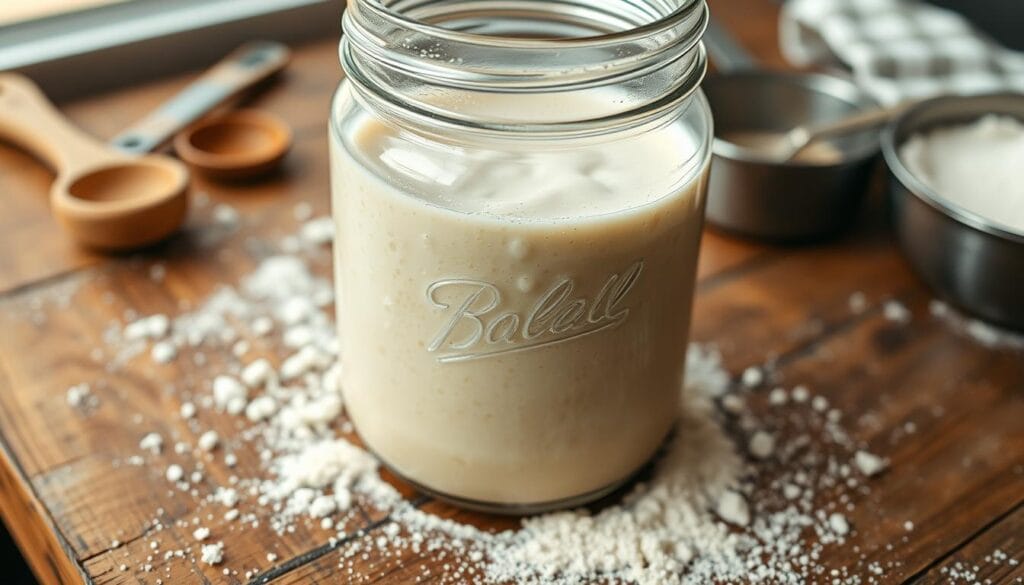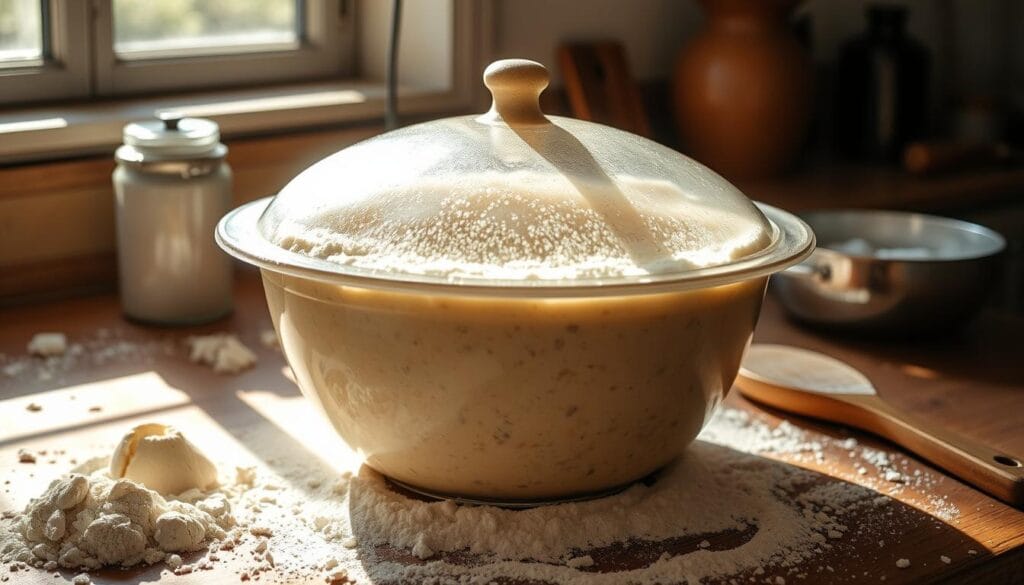I’ve always been fascinated by homemade sourdough bread. The idea of biting into a thick, crusty slice is exciting. It fills the kitchen with a delicious smell. Now, I’m excited to teach you how to make the perfect sourdough sandwich bread.
This bread is soft and fluffy. It will make your sandwiches and toast even better.
Table of Contents
Key Takeaways
- Discover the unique characteristics of sourdough sandwich bread
- Learn the benefits of making your own artisanal sourdough bread
- Understand the essential ingredients and tools needed for the perfect loaf
- Master the art of sourdough starter preparation
- Explore the step-by-step recipe and baking techniques
Understanding Sourdough Sandwich Bread Basics
Sourdough sandwich bread is a tasty twist on the classic. It’s made with a sourdough starter, not commercial yeast. This gives it a tangy taste and a better texture than store-bought bread.
What Makes Sourdough Sandwich Bread Different
The sourdough starter is what makes sourdough sandwich bread special. It’s a mix of flour and water that ferments. This process adds a unique flavor and makes the bread easier to digest. Plus, it lasts longer, which is great for busy homes.
Benefits of Making Your Own Sourdough Bread
- Full control over ingredients, ensuring a healthier, preservative-free product
- Unique, tangy flavor profile that elevates sandwiches, toast, and more
- Improved texture with a soft, tight crumb and a thin, crispy crust
- Better digestibility and a longer shelf life compared to commercial yeast bread
Key Characteristics of Perfect Sandwich Bread
The best sourdough sandwich bread has a soft crumb and a crispy crust. The fermentation makes it both tasty and practical for daily use.
“I bake sourdough sandwich bread at least once a week and haven’t bought store-bought sandwich bread in almost a year and a half. I always have a few starters going and often bake two loaves at a time.”
– Experienced Sourdough Baker
Essential Ingredients for Sourdough Sandwich Bread
Making the perfect sourdough sandwich bread needs the right ingredients. Start with unbleached all-purpose flour from a trusted brand like King Arthur. This flour is key for the bread’s texture and structure, making it soft yet firm.
You’ll also need an active sourdough starter to start the fermentation. This starter gives sourdough its unique taste and light texture. Honey or maple syrup adds sweetness, and light olive oil brings richness and a buttery taste.
Kosher salt is also important. It boosts the flavor and balances the sweetness. A bit of whole wheat flour adds nutrition and flavor depth.
Choosing the best bread ingredients is vital for great homemade sourdough. Each ingredient plays a part in creating a delicious and textured bread.
| Ingredient | Quantity |
|---|---|
| Unbleached all-purpose flour | 1000 grams |
| Warm water | 650 grams |
| Sourdough starter | 300 grams |
| Honey | 50 grams |
| Light olive oil | 40 grams |
| Fine sea salt | 20 grams |
This recipe makes two loaves of tasty and healthy sourdough sandwich bread. It’s great for sharing with family and friends.
“Using high-quality bread ingredients is crucial for achieving the best results in homemade bread.”
Required Tools and Equipment
To bake sourdough sandwich bread at home, you need some key tools and equipment. The right bread pans and special accessories are crucial. They help you make the perfect loaf.
Bread Pans and Mixing Bowls
A good loaf pan is the base of your sourdough sandwich bread. Choose a 9×4-inch size for the classic shape. Glass or metal pans are best for even heat.
You’ll also need a big mixing bowl. It’s where your dough will rise and grow.
Measuring Tools and Accessories
Accurate measurements are vital in sourdough baking. You’ll need a set of measuring cups and spoons. A dough whisk is great for mixing and kneading the dough.
A metal bench scraper is useful for dividing and shaping the dough.
Optional but Helpful Equipment
- A stand mixer with a dough hook attachment makes kneading easier, especially for big batches.
- A kitchen scale lets you measure ingredients by weight, which is better for sourdough.
- A proofing basket (or banneton) helps shape and support the dough during the final rise.
- A bread lame or sharp knife is good for scoring the dough before baking, giving it that sourdough look.
- A digital thermometer helps you check the dough and oven temperatures for the best results.
With these bread making tools, you’re ready to make delicious homemade sourdough sandwich bread.
Preparing Your Sourdough Starter
An active sourdough starter is key for making tasty sourdough sandwich bread. It’s important to feed and care for your bread starters before mixing the dough. Start by feeding your sourdough starter about 12 hours before mixing, using a 1:4:4 ratio of starter, water, and flour for a slow rise.
If you want a quicker rise, use a 1:1:1 ratio. Watch your starter until it’s bubbly and doubled in size. Then, it’s ready to mix into your bread. Keeping your sourdough starter healthy is crucial for great sourdough bread every time.
Sourdough Starter Maintenance Tips
- Feed your sourdough starter with equal parts of flour and water (e.g., 50g each) at least once a day to keep it active and healthy.
- Store your sourdough starter in the refrigerator between uses to slow down fermentation, but remember to feed it before using it in a recipe.
- If your sourdough starter becomes inactive or discolored, discard a portion and refresh it with fresh flour and water to rejuvenate it.
| Ingredient | Weight Percentage |
|---|---|
| Medium-protein bread flour or All-purpose flour | 100.0% |
| Water | 100.0% |
| Ripe sourdough starter | 10.0% |
By following these simple sourdough starter maintenance tips, you’ll be well on your way to baking consistently delicious sourdough sandwich bread that your family and friends will love.

Sourdough Sandwich Bread Recipe
Baking sourdough sandwich bread at home is rewarding and flavorful. This recipe combines sourdough’s classic taste with a soft, sliceable texture. The tangzhong method makes the bread tender, moist, and lasts longer.
Ingredient Measurements and Ratios
To make the perfect sourdough sandwich bread, you’ll need the following ingredients:
- 285 grams of water
- 70 grams of active sourdough starter
- 16 grams of sugar
- 12 grams of oil
- 500 grams of bread flour
- 13 grams of salt
Step-by-Step Mixing Instructions
Start by mixing water, sourdough starter, sugar, and oil in a stand mixer. Use the dough hook attachment. Mix on low speed until everything is well combined. Then, add the bread flour and salt slowly.
Knead the dough for just 20 seconds. This brief kneading helps develop the gluten structure without overworking the dough.
Incorporating the Tangzhong Method
To make the bread even softer and more tender, use the tangzhong method. This method pre-cooks a portion of the flour with water or milk. It improves the bread’s structure, moisture retention, and shelf life.
Mix 25 grams of bread flour with 75 grams of warm water or milk. Cook over medium heat, stirring constantly, until it thickens into a smooth paste. Let the tangzhong cool before adding it to the dough during the initial mixing stage.
By following this sourdough sandwich bread recipe and using the tangzhong method, you’ll enjoy a soft, flavorful, and long-lasting loaf. It’s perfect for all your sandwich needs.
Mastering the Fermentation Process
Making the perfect sourdough sandwich bread needs a good grasp of fermentation. This step is key for the bread’s taste, texture, and structure. Let’s explore the bulk fermentation phase, a vital part of sourdough making.
The bulk fermentation stage lasts 3-4 hours at room temperature, between 68-72°F. You’ll do “stretch and folds” every 30 minutes. This helps the dough’s gluten develop, making the bread airy and chewy.
The length and conditions of fermentation greatly affect your bread. Kitchen temperature and humidity can change the time needed. It’s important to watch your dough closely and adjust as needed. Proper fermentation brings out the bread’s flavor and structure, making it truly special.
“Fermentation is the heartbeat of sourdough bread, breathing life into the dough and unlocking its full potential.”
By getting good at bulk fermentation, you’ll make sourdough sandwich bread that looks great and tastes amazing. Keep an eye on your dough and let fermentation guide you to baking success.

Shaping and Proofing Techniques
Making the perfect sourdough sandwich bread needs careful attention to shaping and proofing. These steps are key to getting the right rise, structure, and crumb texture. They make your homemade loaf truly special.
Creating the Perfect Loaf Shape
Shaping the dough is a few steps. Start by dividing the fermented dough into the right size for your bread pan. Then, shape each piece into a smooth, tight round. Roll each round into a tight cylinder, sealing the seam at the bottom.
Put the shaped loaf seam-side down in your bread pan.
Signs of Proper Proofing
- The dough should rise about 1 inch above the pan rim, showing it’s proofed well.
- When pressed gently, the dough should feel light and airy, not dense.
- Proper proofing takes 2-3 hours at room temperature, or overnight in the fridge.
Learning to shape and proof is crucial for a perfectly risen sourdough loaf. With practice, you’ll soon be shaping and proofing like a pro.
“Proper shaping and proofing are the keys to a tall, well-structured sourdough sandwich loaf.”
Baking Methods and Temperature Guidelines
To get the perfect crust and crumb on your homemade sourdough sandwich bread, pay close attention to baking temperatures and techniques. First, preheat your oven to 450°F (232°C). Then, lower it to 375°F (190°C) when you put the bread in.
Bake the loaf for 45-50 minutes. This will help the crust turn golden-brown. To get a crisp, shiny crust, create steam in the oven. You can do this by placing ice cubes in a hot pan or spraying the oven walls with water.
To check if your sourdough sandwich bread is done, use a digital thermometer. It should read around 190°F (88°C). After reaching this temperature, take the bread out of the oven. Let it cool in the pan for 10-15 minutes before moving it to a wire rack.
Getting the right baking temperature and techniques is key for the crust formation and oven spring that make sourdough bread special. By following these steps, you’ll be able to bake top-notch bread right at home.
Storage and Preservation Tips
Keeping your homemade sourdough sandwich bread fresh is key. Let it cool completely, which takes 1-2 hours, to avoid a gummy inside. Store it at room temperature in a bread bag or reusable beeswax wrap for up to 3 days.
Proper Cooling and Slicing
Don’t slice warm bread too soon. It can make the bread gummy or sticky. Wait until it cools down completely to get the best texture.
Freezing and Thawing Methods
Freezing is great for longer storage. Slice the bread and freeze the slices in an airtight container. This keeps the bread fresh and tasty for a long time. Just thaw and reheat in a toaster for a fresh bread taste.
FAQ
What makes sourdough sandwich bread different from other bread?
What are the benefits of making your own sourdough bread at home?
What are the key characteristics of perfect sourdough sandwich bread?
What are the essential ingredients needed to make sourdough sandwich bread?
What tools and equipment are required for making sourdough sandwich bread?
How do I prepare and maintain my sourdough starter for baking?
Can I incorporate the tangzhong method into my sourdough sandwich bread recipe?
How do I ensure proper fermentation and proofing of the sourdough dough?
What’s the best way to bake sourdough sandwich bread?
How should I store and preserve my homemade sourdough sandwich bread?
Leave us a comment if you like the recipe
There are no reviews yet. Be the first one to write one.

1 thought on “Sourdough Sandwich Bread: 5 Simple Steps to Perfect Loaves”
Comments are closed.